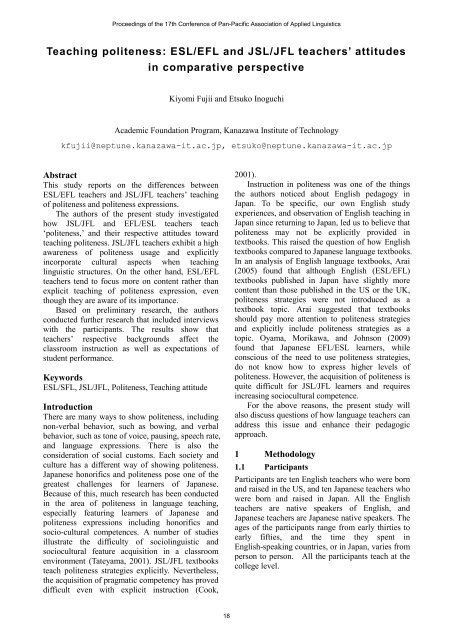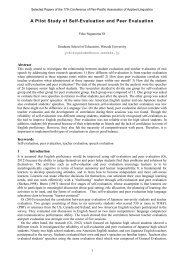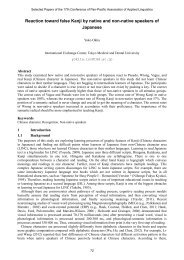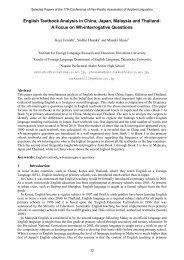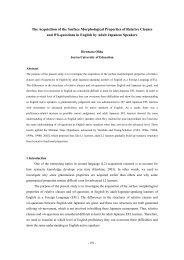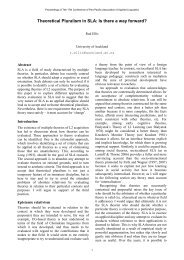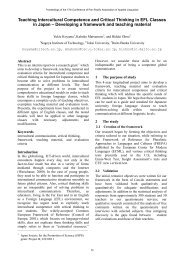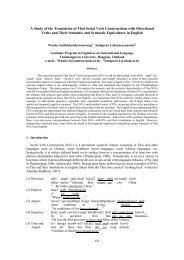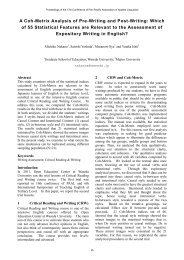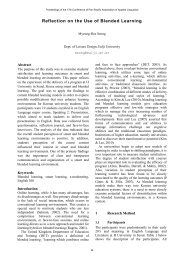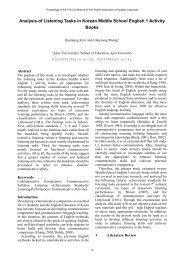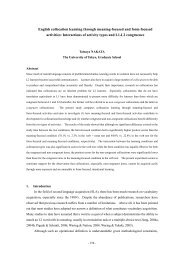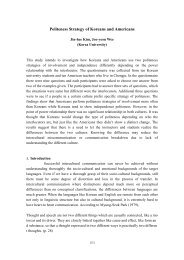Teaching politeness: ESL/EFL and JSL/JFL teachers ... - PAAL Japan
Teaching politeness: ESL/EFL and JSL/JFL teachers ... - PAAL Japan
Teaching politeness: ESL/EFL and JSL/JFL teachers ... - PAAL Japan
You also want an ePaper? Increase the reach of your titles
YUMPU automatically turns print PDFs into web optimized ePapers that Google loves.
Proceedings of the 17th Conference of Pan-Pacific Association of Applied Linguistics<br />
<strong>Teaching</strong> <strong>politeness</strong>: <strong>ESL</strong>/<strong>EFL</strong> <strong>and</strong> <strong>JSL</strong>/<strong>JFL</strong> <strong>teachers</strong>’ attitudes<br />
in comparative perspective<br />
Kiyomi Fujii <strong>and</strong> Etsuko Inoguchi<br />
Academic Foundation Program, Kanazawa Institute of Technology<br />
kfujii@neptune.kanazawa-it.ac.jp, etsuko@neptune.kanazawa-it.ac.jp<br />
Abstract<br />
This study reports on the differences between<br />
<strong>ESL</strong>/<strong>EFL</strong> <strong>teachers</strong> <strong>and</strong> <strong>JSL</strong>/<strong>JFL</strong> <strong>teachers</strong>’ teaching<br />
of <strong>politeness</strong> <strong>and</strong> <strong>politeness</strong> expressions.<br />
The authors of the present study investigated<br />
how <strong>JSL</strong>/<strong>JFL</strong> <strong>and</strong> <strong>EFL</strong>/<strong>ESL</strong> <strong>teachers</strong> teach<br />
‘<strong>politeness</strong>,’ <strong>and</strong> their respective attitudes toward<br />
teaching <strong>politeness</strong>. <strong>JSL</strong>/<strong>JFL</strong> <strong>teachers</strong> exhibit a high<br />
awareness of <strong>politeness</strong> usage <strong>and</strong> explicitly<br />
incorporate cultural aspects when teaching<br />
linguistic structures. On the other h<strong>and</strong>, <strong>ESL</strong>/<strong>EFL</strong><br />
<strong>teachers</strong> tend to focus more on content rather than<br />
explicit teaching of <strong>politeness</strong> expression, even<br />
though they are aware of its importance.<br />
Based on preliminary research, the authors<br />
conducted further research that included interviews<br />
with the participants. The results show that<br />
<strong>teachers</strong>’ respective backgrounds affect the<br />
classroom instruction as well as expectations of<br />
student performance.<br />
Keywords<br />
<strong>ESL</strong>/SFL, <strong>JSL</strong>/<strong>JFL</strong>, Politeness, <strong>Teaching</strong> attitude<br />
Introduction<br />
There are many ways to show <strong>politeness</strong>, including<br />
non-verbal behavior, such as bowing, <strong>and</strong> verbal<br />
behavior, such as tone of voice, pausing, speech rate,<br />
<strong>and</strong> language expressions. There is also the<br />
consideration of social customs. Each society <strong>and</strong><br />
culture has a different way of showing <strong>politeness</strong>.<br />
<strong>Japan</strong>ese honorifics <strong>and</strong> <strong>politeness</strong> pose one of the<br />
greatest challenges for learners of <strong>Japan</strong>ese.<br />
Because of this, much research has been conducted<br />
in the area of <strong>politeness</strong> in language teaching,<br />
especially featuring learners of <strong>Japan</strong>ese <strong>and</strong><br />
<strong>politeness</strong> expressions including honorifics <strong>and</strong><br />
socio-cultural competences. A number of studies<br />
illustrate the difficulty of sociolinguistic <strong>and</strong><br />
sociocultural feature acquisition in a classroom<br />
environment (Tateyama, 2001). <strong>JSL</strong>/<strong>JFL</strong> textbooks<br />
teach <strong>politeness</strong> strategies explicitly. Nevertheless,<br />
the acquisition of pragmatic competency has proved<br />
difficult even with explicit instruction (Cook,<br />
2001).<br />
Instruction in <strong>politeness</strong> was one of the things<br />
the authors noticed about English pedagogy in<br />
<strong>Japan</strong>. To be specific, our own English study<br />
experiences, <strong>and</strong> observation of English teaching in<br />
<strong>Japan</strong> since returning to <strong>Japan</strong>, led us to believe that<br />
<strong>politeness</strong> may not be explicitly provided in<br />
textbooks. This raised the question of how English<br />
textbooks compared to <strong>Japan</strong>ese language textbooks.<br />
In an analysis of English language textbooks, Arai<br />
(2005) found that although English (<strong>ESL</strong>/<strong>EFL</strong>)<br />
textbooks published in <strong>Japan</strong> have slightly more<br />
content than those published in the US or the UK,<br />
<strong>politeness</strong> strategies were not introduced as a<br />
textbook topic. Arai suggested that textbooks<br />
should pay more attention to <strong>politeness</strong> strategies<br />
<strong>and</strong> explicitly include <strong>politeness</strong> strategies as a<br />
topic. Oyama, Morikawa, <strong>and</strong> Johnson (2009)<br />
found that <strong>Japan</strong>ese <strong>EFL</strong>/<strong>ESL</strong> learners, while<br />
conscious of the need to use <strong>politeness</strong> strategies,<br />
do not know how to express higher levels of<br />
<strong>politeness</strong>. However, the acquisition of <strong>politeness</strong> is<br />
quite difficult for <strong>JSL</strong>/<strong>JFL</strong> learners <strong>and</strong> requires<br />
increasing sociocultural competence.<br />
For the above reasons, the present study will<br />
also discuss questions of how language <strong>teachers</strong> can<br />
address this issue <strong>and</strong> enhance their pedagogic<br />
approach.<br />
1 Methodology<br />
1.1 Participants<br />
Participants are ten English <strong>teachers</strong> who were born<br />
<strong>and</strong> raised in the US, <strong>and</strong> ten <strong>Japan</strong>ese <strong>teachers</strong> who<br />
were born <strong>and</strong> raised in <strong>Japan</strong>. All the English<br />
<strong>teachers</strong> are native speakers of English, <strong>and</strong><br />
<strong>Japan</strong>ese <strong>teachers</strong> are <strong>Japan</strong>ese native speakers. The<br />
ages of the participants range from early thirties to<br />
early fifties, <strong>and</strong> the time they spent in<br />
English-speaking countries, or in <strong>Japan</strong>, varies from<br />
person to person. All the participants teach at the<br />
college level.<br />
18
Proceedings of the 17th Conference of Pan-Pacific Association of Applied Linguistics<br />
1.2 Procedure<br />
The participants were asked to fill out a<br />
questionnaire <strong>and</strong> observed some of the <strong>Japan</strong>ese<br />
<strong>and</strong> English classes. The questionnaire directly<br />
asked whether they explicitly teach ‘<strong>politeness</strong>’ in<br />
class. Also, the participants were asked to write<br />
what kind of expressions they would teach in<br />
certain situations where negative or positive<br />
<strong>politeness</strong> is required. Additionally, the participants<br />
were asked to write any linguistic or cultural<br />
information they would provide to the class in order<br />
to teach the expressions.<br />
2 Results<br />
2.1 <strong>Teaching</strong> <strong>politeness</strong> in class<br />
Five out of 10 <strong>ESL</strong>/<strong>EFL</strong> <strong>teachers</strong> said that they do<br />
not teach <strong>politeness</strong>, since they teach content rather<br />
than etiquette. One <strong>ESL</strong>/<strong>EFL</strong> teacher noted that if<br />
s/he were to teach business English, s/he would<br />
emphasize the importance of polite usage. <strong>JSL</strong>/<strong>JFL</strong><br />
<strong>teachers</strong> answered unanimously that they teach<br />
<strong>politeness</strong> in all classes at all levels, but especially,<br />
at the advanced levels.<br />
2.2 Positive <strong>and</strong> negative <strong>politeness</strong><br />
The results show the participants teach the<br />
following situations in which negative <strong>politeness</strong> is<br />
required. When teaching a request form, <strong>JSL</strong>/<strong>JFL</strong><br />
<strong>teachers</strong> answered that they would teach<br />
“teitadakemasenka,” using a negative <strong>politeness</strong><br />
strategy. On the other h<strong>and</strong>, <strong>ESL</strong>/<strong>EFL</strong> <strong>teachers</strong><br />
suggested the use of “may/could I” or “would you<br />
mind if,” indicating that they distinguish the forms<br />
depending on the burden of the request itself.<br />
<strong>Japan</strong>ese <strong>teachers</strong> exhibit more st<strong>and</strong>ardization with<br />
their use of “teitadakaku,” since the status<br />
difference (e.g. teacher-student) is the most<br />
important factor in making a request.<br />
Certain situations, however, require positive<br />
<strong>politeness</strong>, such as students greeting a teacher, or<br />
establishing rapport with the teacher. When a<br />
student responds to a compliment by a teacher, such<br />
as, “your dress is so nice,” or “you speak<br />
English/<strong>Japan</strong>ese very well,” <strong>JSL</strong>/<strong>JFL</strong> <strong>teachers</strong><br />
answered that the students should negate the<br />
compliment, whereas <strong>ESL</strong>/<strong>EFL</strong> <strong>teachers</strong> answered<br />
that it was acceptable to acknowledge it.<br />
Additionally, several <strong>ESL</strong>/<strong>EFL</strong> <strong>teachers</strong> commented<br />
that it was more polite to talk about the item that is<br />
complimented.<br />
<strong>JSL</strong>/<strong>JFL</strong> <strong>teachers</strong> focus on the rigid<br />
teacher-student relationship <strong>and</strong> believe that it is<br />
important to teach <strong>Japan</strong>ese customs in order for<br />
students to adapt to <strong>Japan</strong>ese culture, whereas<br />
<strong>ESL</strong>/<strong>EFL</strong> <strong>teachers</strong>’ answers varied. Some <strong>ESL</strong>/<strong>EFL</strong><br />
<strong>teachers</strong> commented that they would make clear<br />
that even in the US a hierarchical teacher-student<br />
relationship does exist, along with the requisite<br />
rules. Some noted that use of the first name is<br />
acceptable in class, because it indicates that<br />
students take the initiative to communicate <strong>and</strong><br />
want to create a better class atmosphere. The use of<br />
“konnichiwa” in an e-mail message did bother<br />
<strong>JSL</strong>/<strong>JFL</strong> <strong>teachers</strong>, but 3 participants said that they<br />
would not correct it, because the time lag makes<br />
such corrective feedback impractical. <strong>ESL</strong>/<strong>EFL</strong><br />
<strong>teachers</strong> answered that due to the informal nature of<br />
the e-mail, with the delivery of the message being<br />
most important, they were not bothered by the use<br />
of “Hi!” These <strong>teachers</strong> stressed maintaining a good<br />
relationship with students rather than correcting<br />
them, which indicates that <strong>ESL</strong>/<strong>EFL</strong> <strong>teachers</strong><br />
wanting to save the students’ “face.”<br />
3 Pedagogical suggestions<br />
Based on the findings of the current research, a<br />
suggesting can be made that <strong>ESL</strong>/<strong>EFL</strong> <strong>teachers</strong><br />
should incorporate ideas of <strong>politeness</strong> into their<br />
curriculum. Because <strong>politeness</strong> strategies are<br />
difficult to convey without explicit instruction, <strong>and</strong><br />
because English <strong>teachers</strong> rarely teach <strong>politeness</strong><br />
outside of business English, <strong>Japan</strong>ese students lack<br />
the opportunity to talk politely with English<br />
speakers. It follows that they may encounter<br />
difficulties communicating in English-speaking<br />
countries. We submit that teaching <strong>politeness</strong><br />
strategies—positive <strong>and</strong> negative—would prove<br />
effective for <strong>Japan</strong>ese speakers, who are generally<br />
exposed to a limited amount of <strong>politeness</strong><br />
instruction (usually of the positive variety) in the<br />
classroom.<br />
References<br />
Arai, T. (2005). <strong>Teaching</strong> <strong>politeness</strong> in lower<br />
secondary schools in <strong>Japan</strong>: Text Analysis<br />
of <strong>politeness</strong>. Proceedings of the 10 th<br />
conference of Pan-pacific association of<br />
applied linguistics, 15-30.<br />
Cook, H. M. (2001). Why can’t learners of <strong>JFL</strong><br />
distinguish polite from impolite speech<br />
styles? In K. R. Rose & G. Kasper (Eds.)<br />
Pragmatics in language teaching, (pp.<br />
80-102). Cambridge: CUP.<br />
Oyama, N. Morikawa, S, <strong>and</strong> Johnson, K. (2009).<br />
Investigation of the use of <strong>politeness</strong><br />
strategies by <strong>Japan</strong>ese students when<br />
requesting in English. Gengobunkaronso, 3,<br />
91-103.<br />
Tateyama, Y. (2001). Explicit <strong>and</strong> implicit teaching<br />
of pragmatic routines: <strong>Japan</strong>ese sumimasen.<br />
In K. R. Rose <strong>and</strong> G. Kasper (Eds.).<br />
Pragmatics in language teaching, (pp.<br />
200-222). Cambridge: CUP.<br />
19


